Summary
Bottom Line: After researching azelaic acid serums, I found that four Korean brands offer different approaches ranging from “aggressive care” to “gentle care.” Medicube 16% is the most intensive with highest concentration, Cos de BAHA 15% is a proven balanced option, ANUA 15% is surprisingly mild despite high concentration, and VT A1 Ampoule is the gentlest entry point.
I personally started with ANUA and recently switched to Cos de BAHA 15%. Even though both are 15%, the glycerin-free formula works better for my combination skin in Tokyo’s humidity. However, the optimal choice varies depending on skin type and climate, so I hope this comparison helps you find yours.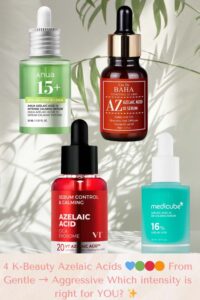
Introduction
Azelaic acid has been gradually gaining popularity in Japan lately. I’ve been noticing it more frequently in beauty YouTube videos and getting curious about it. Korean brands’ azelaic acid products have become increasingly accessible in Japan, and reviews on @cosme have been growing.
Azelaic acid is known for its effectiveness on pores, sebum, and acne marks, but I learned that products differ significantly between “aggressive care” and “gentle care.” Through my research, I discovered that irritation levels depend not just on concentration but on the overall formulation balance.
Today, I’m comparing four particularly popular K-Beauty products in Japan. I actually used ANUA myself and recently switched to Cos de BAHA. I’d love to share these findings including my reasons – good products deserve to be shared, right?
What is Azelaic Acid?
Azelaic acid is a naturally derived ingredient found in grains like wheat and barley. In Korea, it’s popular for addressing the “three major concerns” – pores, sebum, and acne.
Main Functions:
- Regulates excessive sebum production
- Addresses pore congestion
- Suppresses melanin formation to prevent acne marks
- Smooths skin texture
Important Points to Know:
Through my research, I learned that higher concentration doesn’t always mean stronger effects. When formulas contain alkaline ingredients for neutralization, the actual intensity becomes milder than the stated concentration. Also, crystals may appear with overuse, but this can be prevented by sealing properly with moisturizer or cream.
For first-time users, I recommend starting with spot application.
Quick Comparison Table
| Product | Concentration | Irritation Level | Texture | Recommended For | Price Range |
|---|---|---|---|---|---|
| Medicube 16% BBB | 16% | High (Aggressive) | Watery, Blue color | Oily skin, Spot use | Mid-High |
| Cos de BAHA 15% | 15% | Medium-High | Slightly viscous | Combination, Night use | Mid |
| ANUA 15% | 15% | Low-Medium (Mild) | Light, smooth | Combination-Sensitive | Mid |
| VT A1 Ampoule | Undisclosed | Lowest (Gentle) | Water-like | All skin types, Beginners | Mid |
Product Reviews
1. Medicube Azelaic Acid 16% BBB Calming Serum – Most Aggressive Care
Medicube’s 16% serum contains the highest concentration of azelaic acid among the products I’m introducing today. Its distinctive blue color gives a powerful impression from the start.
What Caught My Attention
Looking at the ingredient list, azelaic acid appears right after water, indicating high concentration. The texture is surprisingly watery and light, but given this concentration, it seems like something to use cautiously.
Product Claims
According to the manufacturer, the 16% high-concentration azelaic acid provides intensive acne care and sebum regulation. They emphasize BB (Barrier + Balance) calming care.
Review Patterns
Looking at @cosme reviews, reports of irritation stand out. Comments like “it stung painfully when applied to my face” and “flaking occurred within 5 minutes” appear. On the other hand, some say “hardly any irritation, skin texture improved,” showing reactions vary significantly by skin type. Many users seem to use it for spot application.
Who It’s Suitable For
This could be an option for those with oily skin seeking intensive spot care on T-zone areas. However, for those with dry or sensitive skin, or those considering full-face application, the irritation may be too strong. It’s safer to start by moisturizing well after toner, then trying it only on areas of concern.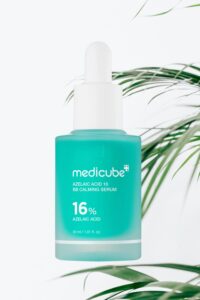
2. Cos de BAHA Azelaic Acid 15% Serum – My Balanced Choice
Cos de BAHA is known as a “pioneer of azelaic acid” Korean brand with over 1.3 million units sold. Despite 15% concentration, it also contains niacinamide and panthenol.
Why I Made the Switch
I was actually using ANUA before, but during Tokyo’s humid seasons, it sometimes felt a bit heavy. When comparing ingredients, I noticed Cos de BAHA is glycerin-free. Since both are 15% concentration, I thought it was worth trying.
In actual use, while it has slight viscosity, it doesn’t leave residue on the skin surface. For my combination skin, this refreshing feel was a better match. When I use it thoroughly in my nighttime routine, I notice my skin’s roughness settles down by morning.
Brand’s Explanation
According to the product description, it combines 15% azelaic acid with niacinamide for brightening care and panthenol for moisturizing support. The formula is designed to simultaneously address skin troubles and dryness.
User Voices
Many comments mention the texture: “feels slightly sticky,” “wasn’t sure what to apply after this.” Regarding effects, opinions are mixed between neutral comments like “didn’t feel it working but didn’t worsen either” and positive ones like “helped with recurring acne.”
Who It’s Suitable For
While reviews are mixed, I think it’s worth trying for those who find glycerin heavy or use products in humid environments. Conversely, it might disappoint those seeking light texture or immediate results. I recommend using it in your nighttime routine, before cream.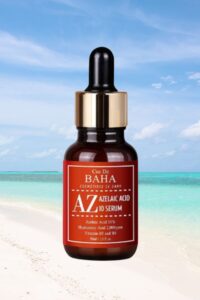
3. ANUA Azelaic Acid 15% Intense Calming Serum – Mild High Concentration
ANUA’s serum is an intriguing product with many reviews noting “low irritation” despite 15% high concentration. It contains glycyrrhizin 2K and CICA components derived from centella.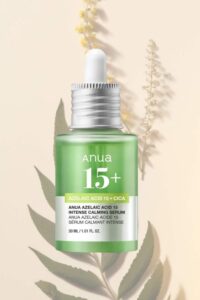
Why I Used This
ANUA was actually my first choice. I found a review on @cosme saying “4th bottle repurchase,” and wondered why a high-concentration product had so many repeat customers. Looking at the ingredients, it had solid calming components, achieving a balance of offensive and defensive care.
The feel was truly mild – surprisingly gentle for 15%. Being able to use it morning and night was great, but during Tokyo’s humid periods, it felt slightly heavy, which led to my switch.
Product Features
According to the manufacturer, it regulates sebum with 15% azelaic acid while suppressing inflammation with glycyrrhizin and totarol, and ANUA’s unique CICA 7 complex balances skin condition. It was developed for those concerned with acne and excess sebum.
Review Trends
Positive comments stand out: “fewer breakouts than before,” “no dryness or irritation,” “noticeably smaller pores, finer texture.” Notably, many sensitive skin users report “no irritation.” Many use it morning and night.
Who It’s Suitable For
I think it’s ideal for those seeking high-concentration yet gentle care, or sensitive skin types wanting to try azelaic acid. For those sensitive to humidity like me, or those preferring refreshing textures, seasonal rotation might work well. I’d also recommend it for first-time high-concentration azelaic acid users.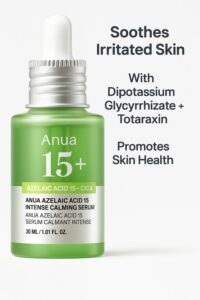
4. VT A1 Calming Ampoule – The Gentlest Approach
VT’s red ampoule from their Personal Color Ampoule series. While concentration is undisclosed, many reviews note its water-like watery texture with almost no irritation.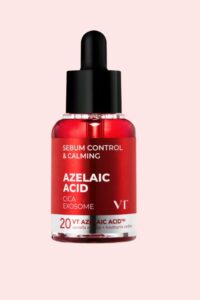
My Impression
The red ampoule looks cute, but what surprised me was how watery it is. Reviews frequently use expressions like “super watery” and “like water,” suggesting a lightness that sets it apart from previous azelaic acid products. I thought this lightness might actually work well in hot climates like Singapore or the Philippines.
Brand’s Description
According to VT, it combines 99% pure azelaic acid with balancing care ingredients like centella extract and houttuynia extract. It’s artificial fragrance-free, a light water serum type that provides refreshing hydration.
User Experience
Reports of zero irritation dominate: “no tingling at all,” “gentle sensation with no irritation,” “no stickiness or irritation.” Some mention “crystallization,” but this can occur with azelaic acid’s properties and isn’t problematic if shaken well.
Who It’s Suitable For
Perfect for beginners thinking “I want to try azelaic acid but worry about irritation.” Easy to apply to full face, seems safe even for dry skin. For those living in hot, humid climates, this watery feel should work well. However, with possibly lower concentration, those seeking immediate results might find it insufficient.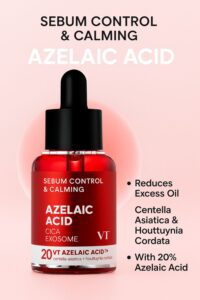
Real User Comments
30s, Combination skin (ANUA user):
“4th bottle repurchase. I tried other azelaic acid products but 15% works best. No dryness or irritation, can use morning and night.”
24, Sensitive skin (ANUA user):
“Noticeably smaller pores, or rather, finer texture. Roughness also improved.”
35, Normal skin (Medicube user):
“It stung painfully when applied to my face and continued for a while. I’m not sensitive-skinned, but wonder if everyone experiences this? Will use it for spot application.”
25, Oily skin (Medicube user):
“Flaking occurred within 5 minutes of application. This seems scary to put on skin.”
34, Dry skin (Cos de BAHA user):
“I used 5% too, but 10% works better for daily use. Feels a bit heavy in summer, so I adjust the amount based on skin condition.”
31, Combination skin (VT user):
“I’ve used many azelaic acid series, but this is by far the most watery. Easy to apply to full face! No tingling at all.”
42, Dry skin (VT user):
“Super watery liquid that absorbs immediately. No stickiness or irritation. Likely because of high concentration, it had crystallized.”
Things to Consider
About Azelaic Acid “Intensity”
Through my research, I learned that higher concentration doesn’t always mean stronger effects. The overall formulation balance, especially neutralization with alkaline components, affects actual irritation levels. Among these four products, Medicube at 16% shows stronger irritation, while ANUA at 15% is relatively mild – concentration alone doesn’t tell the full story.
About Crystallization
VT and Medicube reviews mention “crystals appeared.” This happens when azelaic acid reaches saturation and solidifies – it’s not product deterioration. Shaking well before use and sealing properly with moisturizer or cream can prevent this.
Importance of Starting with Spot Application
Especially when trying high-concentration products (Medicube, Cos de BAHA) for the first time, avoid applying to full face immediately. Start with small amounts on T-zone or areas of concern. It’s wise to gradually expand coverage while observing skin’s reaction.
Using in Southeast Asian Climate
In hot, humid environments like Singapore and the Philippines, watery types (VT, Medicube) might be more comfortable. Heavier textures (Cos de BAHA) seem better suited for nighttime use in air-conditioned rooms.
Best Choice Recommendations
For Intensive Care Seekers: Medicube 16%
For oily-skinned individuals wanting “results at any cost,” maximum-concentration Medicube is an option. However, given high irritation risk, I strongly recommend starting with patch testing and spot application. Not suitable for dry or sensitive skin, or those considering full-face use.
For Those Finding Glycerin Heavy: Cos de BAHA 15% (My Choice)
This is what I chose. Same 15% as ANUA, but the glycerin-free formula suits Tokyo’s humidity and my combination skin. While slightly viscous, it has a refreshing feel without leaving residue. Reviews are mixed, but I think it’s worth trying for those using products in humid environments.
For Gentle High Concentration: ANUA 15%
ANUA is ideal for those wanting “high concentration without irritation.” I used this initially and it was truly mild and great. With many repeat customers and morning-night usability, it’s appealing. Recommended for combination or sensitive skin, and first-time high-concentration azelaic acid users.
For Beginners & Hot Climates: VT A1 Ampoule
VT is the safest choice for those thinking “first time with azelaic acid” or “worried about irritation.” Watery and easy to use, with gentleness allowing full-face application. In hot climates like Singapore or the Philippines, this lightness should actually work well. Effects may come slowly, but skin trouble risk is minimal.
FAQ
Q: Can azelaic acid be used in the morning?
A: Generally yes, morning use is possible. However, high-concentration products (Medicube, Cos de BAHA) have more voices recommending nighttime-only use. Many use ANUA and VT morning and night. When using in morning, always combine with sunscreen.
Q: Which is best for acne marks?
A: Azelaic acid suppresses melanin formation, so it’s effective for “preventing future acne marks.” Existing pigmentation may take time. Higher concentration might be more effective, but considering irritation risk balance, something like ANUA might be easier to continue.
Q: Can I combine with other active ingredients?
A: Combining with other actives like retinol or AHA/BHA may increase irritation. Especially with high-concentration products, consider separating AM/PM or alternating days. Consult a professional if unsure.
Q: How long until I see results?
A: Based on reviews, sebum regulation shows in 1-2 weeks, pore and texture changes in 4-8 weeks. Acne mark effects may take even longer. Best to continue for at least one bottle (1-2 months) to evaluate.
Q: Is crystallized product unusable?
A: Crystallization isn’t quality deterioration but a property of azelaic acid. Shake well before use and it’s fine. If still concerned, warming in your palms before application helps dissolve crystals.
Final Thoughts
After researching azelaic acid serums, I really feel that Korean brands offer truly diverse options. The appeal lies in choosing from “aggressive care” to “gentle care” based on your skin type and goals.
Personally, switching from ANUA to Cos de BAHA 15% was the right decision. The glycerin-free aspect matched Tokyo’s humidity and my skin type. Reviews were mixed, but I realized you ultimately have to try it on your own skin.
But ANUA’s gentleness was also wonderful, and VT’s watery feel is attractive. My friend in Singapore says “VT is perfect for hot climate,” and I really see how optimal solutions vary by climate and skin type.
I think it’s important not to be misled by concentration numbers alone, but to prioritize irritation levels from reviews, texture, and above all, sustainability. High concentration means nothing if it doesn’t suit your skin, and mild formulas can show results with consistency.
Used correctly, azelaic acid can become a strong ally for pores, sebum, and acne marks. Why not start by finding the right “intensity level” for yourself?
About This Review
About the Author: MIYABI, GlowCache Editor
Tokyo-based beauty enthusiast interested in Japanese and Korean beauty products. I value real user experiences while sharing information. All opinions are personal and based on product research and available user feedback.
Reference Sources:
Official brand websites and user reviews
Last Updated: September 2025 | Product information based on manufacturer descriptions and user reviews.
This review aims to provide information based on personal research and user voices, and is not medical advice. If you have skin concerns, please consult a specialist.
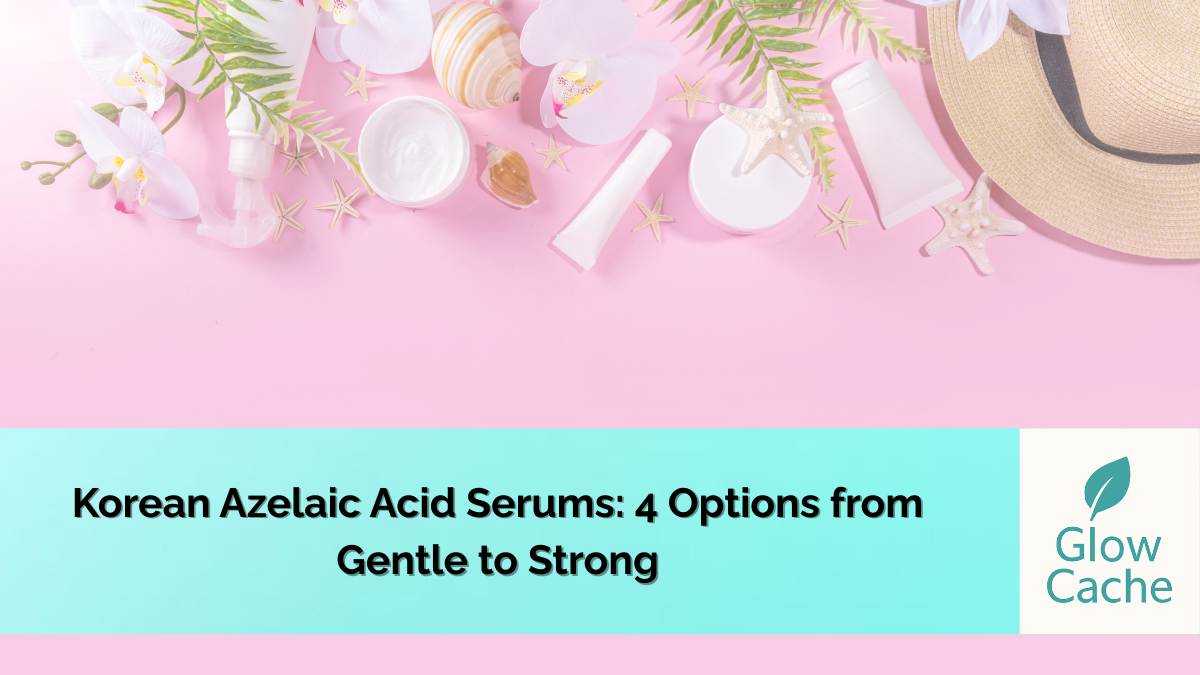


コメント